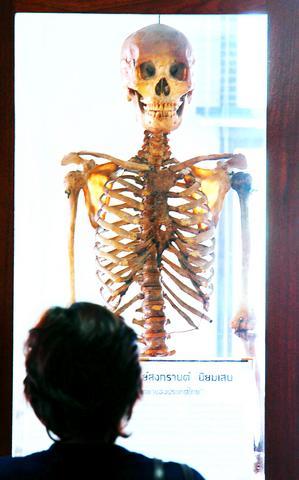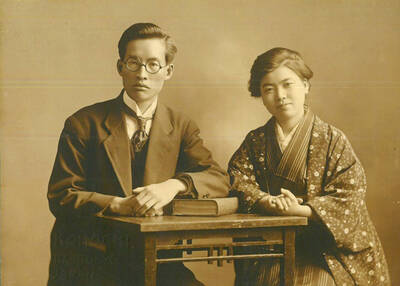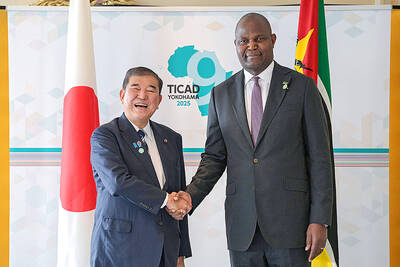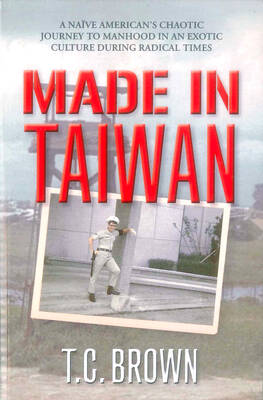It's a rare museum where visitors are welcomed by the founder's skeleton. But the father of Bangkok's Forensic Museum donated his body to his life's cause, and his bones now rest in peace at the entrance for medical students and ordinary onlookers to examine.
This macabre monument to death and its causes attracts more visitors -- often 100-plus a day -- than any art gallery and many other museums in Thailand's capital. They range from those with a morbid curiosity to serious students of medicine and forensic science.
Visitors can study hemorrhaged brains, severed arms with tattoos, and lungs with stab wounds. In one case are skulls punctured by bullet holes, shot at from different angles by forensic scientists in an experiment to study how bullets ricochet inside a human head. Results helped them analyze evidence in murder cases.

PHOTO: AP
At the doorway is the skeleton of Songkran Niyomsane, Thailand's father of forensic medicine and the museum's founder. He died in 1970.
By far the most popular display is the mummified body of Si Ouey, a notorious cannibal and serial killer of boys and girls in the late 1950s.
``Don't commit a crime, otherwise you will end up like this,'' joked Dr. Somboon Thamtakerngkit, the museum curator and chief of forensic pathology at Siriraj Hospital, where the museum is located.
Somboon said Thai mothers used to scare naughty children with tales of Si Ouey, who was finally caught when the father of one victim and a policeman discovered him at home about to partake of a child's organs.
``Si Ouey thought that it was healthy to eat fresh livers and hearts,'' said Somboon
Now, Si Ouey, shriveled, brown and coated in wax to prevent mold, slumps against the glass of a phone-booth-like case. A close look reveals incisions in his head made by Thai pathologists who examined his brain for any abnormalities that would mark a serial killer.
Many of the displays teach medical students and visitors about the body and what can go wrong with it. And also serve as graphic warnings.
``We call the dead bodies `Big Teacher.' We respect the bodies as if they were our teachers or professors. Without them we wouldn't be able to learn,'' Somboon said.
One set of blackened lungs may give second thought to smokers. An aorta with calcium deposits shows how heart attacks result from clogged arteries. One heart is twice its normal size from hypertension.
Reactions range from scientific curiosity for the human body to grimaces of revulsion, and from giggles to quiet respect for the dead.
Some visitors decide to leave candies or toys near the bodies of babies preserved in formaldehyde.
One baby boy is displayed as an example of hydrocephalus, a condition in which the head becomes too large for the body to support. Somboon explained, ``We asked the parents -- `Can we keep the body? Then if you miss him, you can come and see him.' They said OK, and so we have him.''
One visitor, Pearl Tay, stood near a photo of a woman who was choked to death and noted that visiting after lunch might not be the best idea,
Her friend, Victor Chia, who is a biology buff from Singapore, called the museum ``extraordinary.''
``It's not available in our own country,'' he said. ``It's very definitely not what you see in other museums.''

Aug. 25 to Aug. 31 Although Mr. Lin (林) had been married to his Japanese wife for a decade, their union was never legally recognized — and even their daughter was officially deemed illegitimate. During the first half of Japanese rule in Taiwan, only marriages between Japanese men and Taiwanese women were valid, unless the Taiwanese husband formally joined a Japanese household. In 1920, Lin took his frustrations directly to the Ministry of Home Affairs: “Since Japan took possession of Taiwan, we have obeyed the government’s directives and committed ourselves to breaking old Qing-era customs. Yet ... our marriages remain unrecognized,

During the Metal Ages, prior to the arrival of the Dutch and Chinese, a great shift took place in indigenous material culture. Glass and agate beads, introduced after 400BC, completely replaced Taiwanese nephrite (jade) as the ornamental materials of choice, anthropologist Liu Jiun-Yu (劉俊昱) of the University of Washington wrote in a 2023 article. He added of the island’s modern indigenous peoples: “They are the descendants of prehistoric Formosans but have no nephrite-using cultures.” Moderns squint at that dynamic era of trade and cultural change through the mutually supporting lenses of later settler-colonialism and imperial power, which treated the indigenous as

An attempt to promote friendship between Japan and countries in Africa has transformed into a xenophobic row about migration after inaccurate media reports suggested the scheme would lead to a “flood of immigrants.” The controversy erupted after the Japan International Cooperation Agency, or JICA, said this month it had designated four Japanese cities as “Africa hometowns” for partner countries in Africa: Mozambique, Nigeria, Ghana and Tanzania. The program, announced at the end of an international conference on African development in Yokohama, will involve personnel exchanges and events to foster closer ties between the four regional Japanese cities — Imabari, Kisarazu, Sanjo and

By 1971, heroin and opium use among US troops fighting in Vietnam had reached epidemic proportions, with 42 percent of American servicemen saying they’d tried opioids at least once and around 20 percent claiming some level of addiction, according to the US Department of Defense. Though heroin use by US troops has been little discussed in the context of Taiwan, these and other drugs — produced in part by rogue Chinese Nationalist Party (KMT) armies then in Thailand and Myanmar — also spread to US military bases on the island, where soldiers were often stoned or high. American military policeman